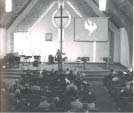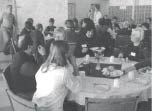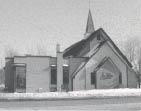Updated April, 2025
Many churches across Canada have been celebrating their fiftieth anniversaries the last few years. Following the end of World War II, the population of Canada exploded with immigrants, including many from the Netherlands who were grateful for the Canadian army’s role in the liberation of their country. As a binational denomination with Dutch roots, the Christian Reformed Church (CRC) in Canada grew from thirteen small congregations in 1945 to 170 in just fifteen years.
Calvin Christian Reformed Church is one of those immigrant churches celebrating fifty years of God’s faithfulness. It began in 1953 in Ottawa, the capital of Canada. Since then, it has given birth to several daughter churches in the area, and it continues to welcome a significant number of individuals and families who come to Ottawa for work and study. The rapid development of the city in the past twenty years has resulted in Calvin CRC’s development from a suburban congregation in a western suburb of Ottawa to an urban congregation, and from a community of Dutch immigrants to a congregation with many different roots. Like the city of Ottawa itself, Calvin CRC includes professionals from a variety of occupational backgrounds, primarily high-tech professionals, government workers, college and university students, public and Christian school educators at all levels, and retired individuals and couples.

A Commitment to Participatory Worship
About eight years ago, Calvin CRC began a deliberate move toward a convergence or blended style of worship, drawing from a wide range of old and new traditions. Pastor Ken Gehrels, who began a three-year professional development course at the Institute for Worship Studies with Robert Webber (www.iwsfla.org), has been instrumental in leading the congregation to a deeper understanding of worship and guiding them in implementing many changes. Guiding the congregation through this period of change has meant prayerful, pastoral leading that is driven from the grassroots of the congregation and its musicians and worship committee.
Worship planning at Calvin CRC is highly participatory. After themes for a specific period of time are set by the pastor and worship committee, an ongoing group of twenty-five worship planners work out the details; their contributions vary from song selection to preparation of complete services. Having such a wide range of people involved leads to a fairly balanced selection of music and liturgical practices over a period of several months. Liturgy coordinator John Kralt puts these elements all together and prepares both a printed liturgy for the bulletin and a scripted version for leaders.
A typical morning service at Calvin CRC begins with a time of preparation, including a musical prelude, sometimes the teaching of new songs, and artwork on an overhead screen that is related to the church season or the theme of the day. The time of preparation ends with the procession of the pastor and an elder who brings in the Bible and opens it to the Scripture of the day. This action represents the beginning of the corporate worship time.
Before and after the worship services, a quiet, comfortable prayer room, simply decorated according to the church year, is open. Several members of the church gather there before worship to lift up the participants of the service in prayer, to pray for the worship of the congregation, and to pray that God will be glorified and praised through their worship. They gather again following the service to give thanks and to pray with anyone who arrives requesting a prayer partner.

Music
The worship committee describes their congregation as one that enjoys “singing a new song to the Lord” while not letting go of its traditional roots and Reformed heritage. Two music teams are scheduled for the first and third Sunday morning services and for the second and fourth Sunday evening services; the remaining services are led by organ and/or piano. The music teams meet during the week and on Sunday to pray, prepare, and evaluate. They function as small groups whose members care for one another and lift each other up in prayer. And they frame the worship services with prayer as they circle in the front of the sanctuary both before and after the service.
Worship planners have introduced more music styles, including new songs and historic hymns. Technological changes began with using overheads and moved to presenting all songs and readings in Corel presentations. Committee members note that although the newer technology makes it easier to introduce new songs without fumbling about looking for the correct overheads, it does not allow for much spontaneity in worship; as a result, worship services can seem more and more like rehearsed events.

Visual Arts
Because the congregation believes that worshipers should be nourished by having all of their senses devoted to the worship of the Lord and replenished for service in the world, they have added visuals and movement to their worship (see front cover and p. 18).
The adoption of new video technology has been very effective in allowing them to explore greater use of visual arts in worship. In addition to the rich variety of art in the building (featured in RW 42), they have added art and symbols available electronically from throughout the world. A video projector plays a key role in all parts of worship with words, images, artwork, or liturgical color. During a Lenten service in March 2003, for example, artwork by G. Carol Bomer (Soli Deo Gloria Studio, Asheville, North Carolina, www.carolbomer.com) entitled Ashes, Ashes, We All Fall Down was projected during the time of confession; the title phrase was repeated as a refrain in the prayers of the people.
As the church gradually introduced more use of candles, artwork, symbols, and dramatic movement, the pastor explained the significance of the changes in a variety of ways, including sermons, bulletin notes, or through the children’s time.

Support and Encouragement
Worship planners say that Calvin’s participatory model of worship planning has been a blessing. But they also acknowledge that the work is labor-intensive and requires much support and encouragement for the volunteers. The worship committee works to ensure the development of the worship leaders and musicians by providing them with tools and opportunities to learn and grow in their ministry.
And they continue to ask questions like the following about worship:
• How can we better integrate the arts and symbols in our worship?
• How can we make more effective use of the sacraments in our worship? In particular, should we celebrate communion more often?
• How can we better incorporate a global, all-encompassing perspective in our worship? That is, how can we make sure that corporate worship is not only about what takes place inside these four walls but that it also has everything to do with what goes on in our homes, our work, our city, our country, and our world?
These questions continue to be discussed and processed with care, with a view toward worshiping in a dialogic, participatory way.
Want to Know More?
Look up Calvin CRC at www.calvincrc.ca. The congregation encourages Web visitors—they even have the Web address etched on the new glass entrance doors of the church. Those who enter the doors will find a warm welcome (even in the cold Ottawa winters!) and will be welcomed into the community. A recent building addition offers a large, sunny welcoming space that has resulted in an increase in after-church coffee from 50 to 300 cups! The addition also houses the church’s catering service, “The Friendly Hands,” which fed the 100 participants in a recent worship conference sponsored by the Calvin Institute of Christian Worship and Calvin CRC—the occasion for my visit to the church.

